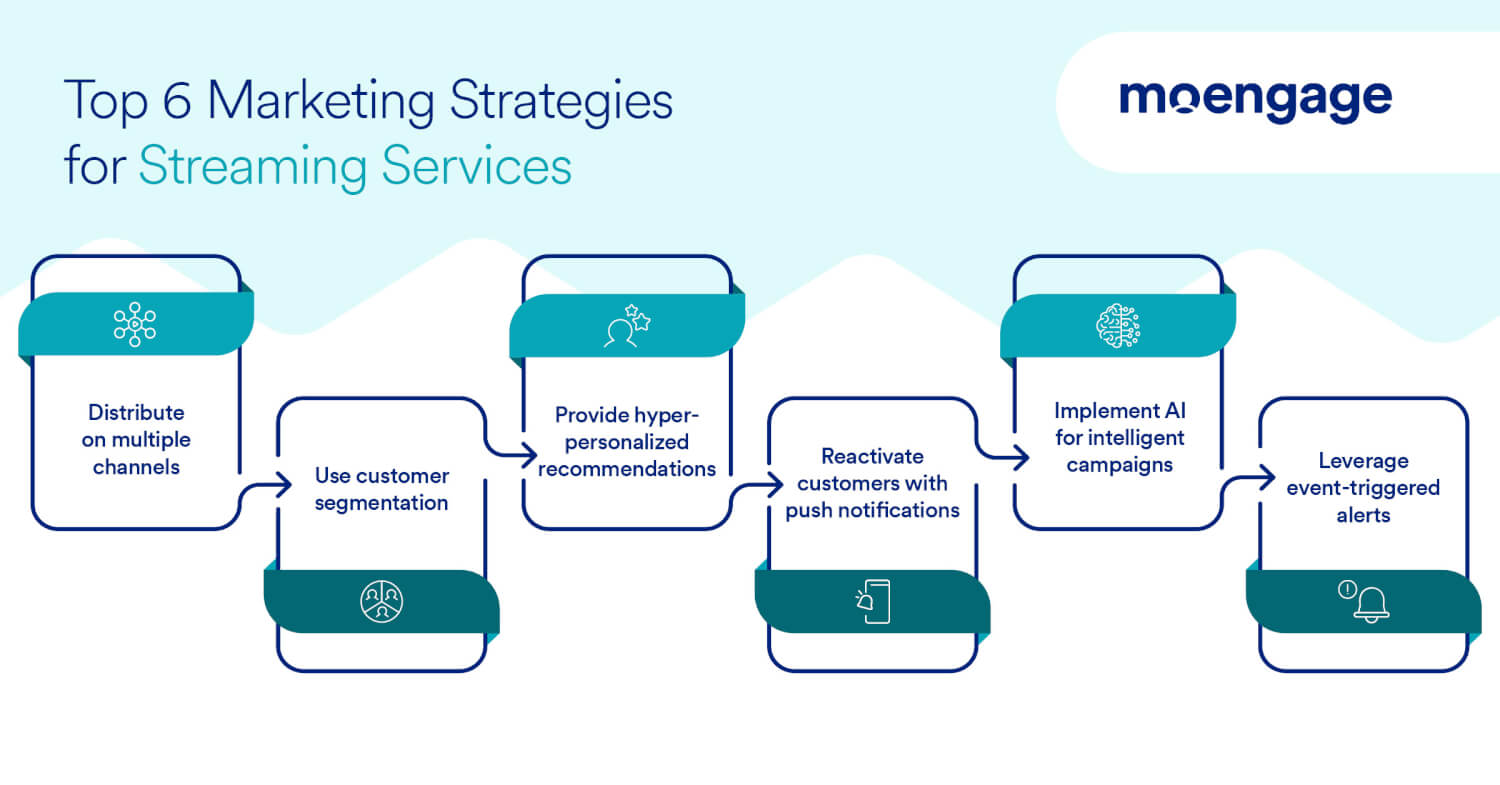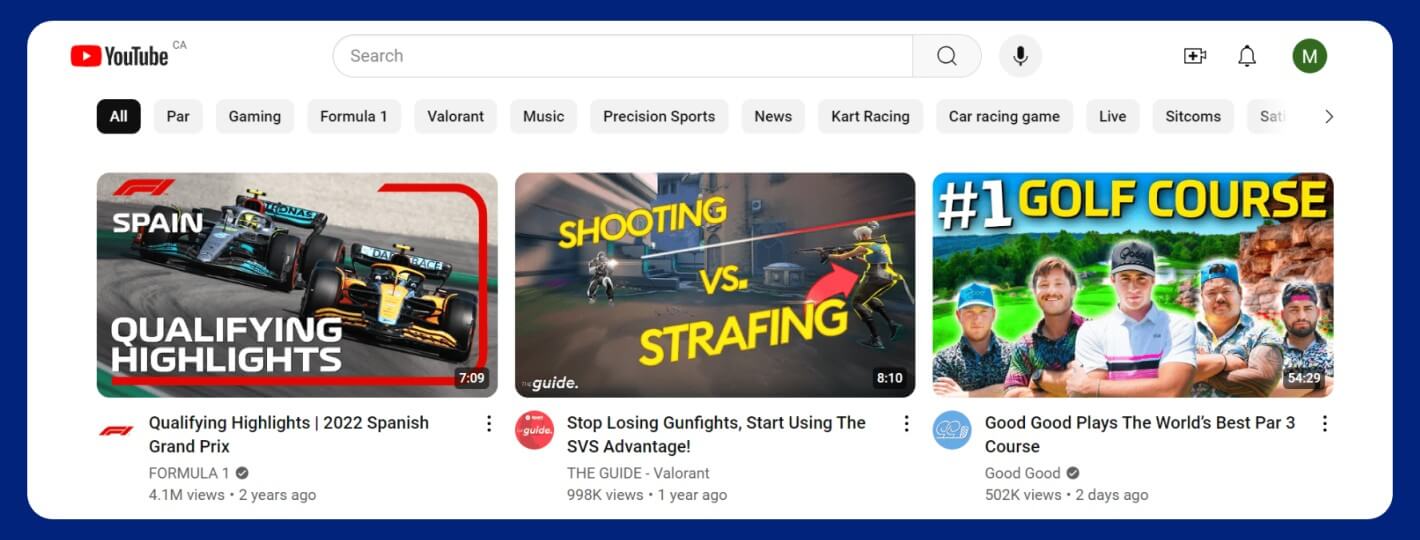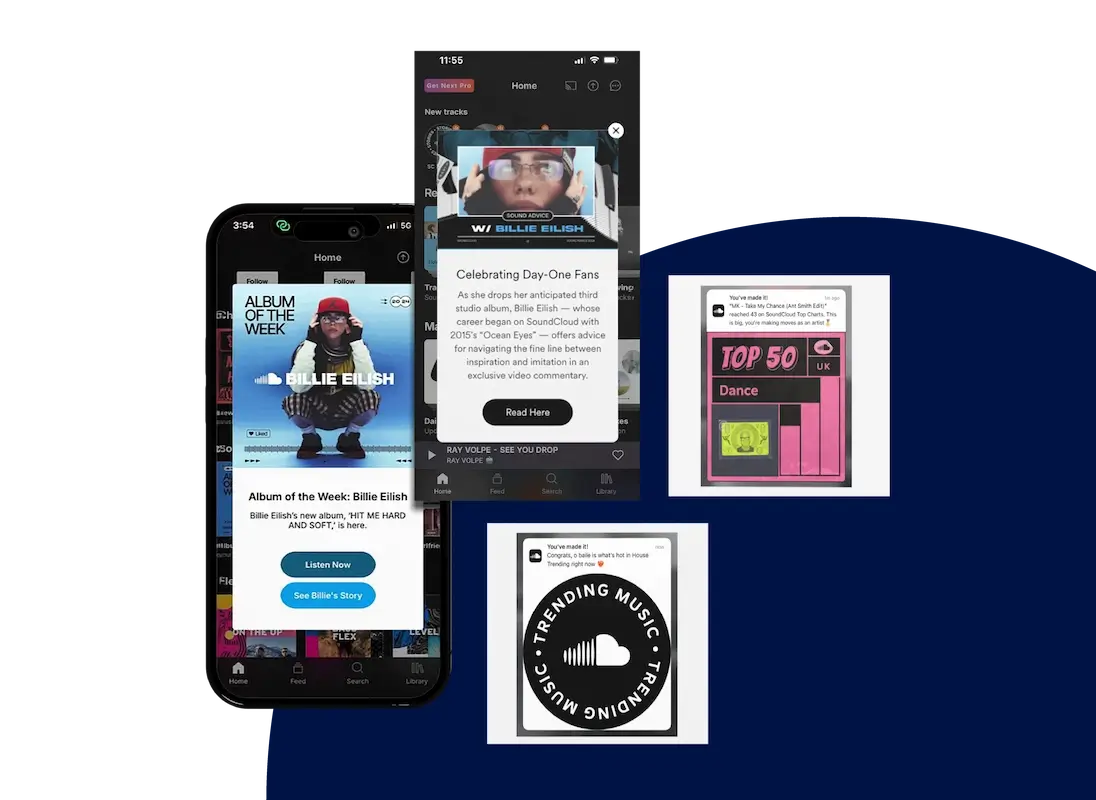6 Impactful Marketing Strategies for Streaming Services

Reading Time: 11 minutes
For a long time, marketing within the streaming ecosystem relied fundamentally on mass marketing: broadly deliver and the content exposes and speaks for itself. Customers engage every day and they are exposed to the content merely by being on the platform. However, with the rise of competitors in recent years, it is no longer an option to leave the marketing of a streaming service to languish in this way.
Our Customer Engagement Benchmarks 2024 report revealed that Media and Entertainment is the most popular industry in terms of consumer spending. Projections also show that consumer spending on media and entertainment is expected to increase to USD 903.2 billion by 2027. This displays just how much money is on the table for over-the-top (OTT) and streaming distributors willing to revitalize their marketing strategy.
In this article, we will explore what marketing opportunities are available to benefit different types of streaming services, how the services differ, and the top marketing strategies that streaming brands can leverage to drive customer engagement.
What Does Marketing for Streaming Services Entail?
High saturation is pushing streaming services to change the way they execute customer engagement. Just promoting content is no longer enough, streaming services need to provide personalized communication and a seamless, interconnected experience to their customers.
With a wide variety of streaming services (movies, television, music, radio, and live events, etc.), it’s harder than ever to attract — and keep — customer attention.
Effectively marketing streaming services comes down to providing the right messaging at the right time to the relevant customers, through highly personalized communication.
At the same time, the adoption of subscription-based revenue models has made retention a priority for most streaming services. Successful brands drive customer retention and increase app stickiness by building engaging customer experiences throughout the entire customer lifecycle: from acquisition, to onboarding, to purchase and post-purchase.
What Are the Benefits of Marketing for Streaming Services?
Customers have a wide array of streaming options, but a limited number of hours to spend on their devices. Hence, for streaming services, retention is imperative. It’s what keeps customers coming back to renew subscriptions, consume content, and view ads. In fact, effective marketing enables streaming services to increase customer engagement and realize other main objectives.
Elevating your streaming service marketing can improve customer engagement and sets up brands to benefit in the following ways:
- Improved brand awareness and conversions: For entertainment brands to capture customer attention, they need to increase their exposure so that customers recognize them — and think of them when they have to decide what content to consume or service to use. Effective marketing can dramatically increase brand exposure and drive conversions and subscription renewals.
- Increased retention and ROI: The more time customers engage with your marketing communication, the more time they end up using your service, cementing them as loyalists for your brand. This increase in retention directly translates into more subscription renewals and ad revenue.
- Obtain insight on your audience: Streaming services live and die by their ability to provide customers relevant content that their customers are actually interested in. By collecting omnichannel analytics that provide deep insights into customer activity, behavior, and preferences, you’re better equipped to deliver personalized recommendations that connect customers with content they love.
While all of these benefits are achievable for streaming services, different types of streaming services will need to employ different strategies to get the best results they can.
In the next section, we discuss the common types of streaming service brands and how they can effectively market to their customers.
Marketing for Different Types of Streaming Services
Though it started with over-the-top media (OTT), digital entertainment in all of its forms has now expanded into the streaming market. And top media & entertainment marketers are accelerating brand growth and engagement by perfecting their marketing strategies.
Each form of streaming benefits from different strategies to ensure customers remain engaged with their distribution platforms.

Regardless of the focus of your streaming service, there is value in observing the way direct and indirect competitors operate.
OTT 🎥
OTT (over-the-top) is a direct response to classic cable video distribution methods. It was instituted to bypass traditional channels and present video content (like movies and TV) directly to the consumer base.
Netflix established itself as the leader of this new wave of media distribution beginning with mail-out DVDs and evolving to video streaming distribution. Now, 99% of households in America subscribe to one or more video streaming services.
Having a well-developed OTT marketing strategy is key when competing in a tough market with big names like HBO and Disney+. But while this is an extremely competitive market, it’s also a huge one — rife with opportunity.
Due to the high level of saturation in the video streaming market, proving that you offer a seamless, best-in-class experience is key.
Netflix changed the game in video, and is still one of the primary contenders in the market because their customer experience is tight. They deliver on their interface and ensure ease of use across all channels of access. They also engage their customers with website personalization and mobile by sending tailored alerts – keeping their platform top-of-mind.
Audio: Music, podcasts, and radio 🎧
Audio streaming has become extremely popular with the rise of music streaming, podcasts, and audiobooks.
As of 2021, music streaming surpassed radio, with 41% of American listeners accessing music via streaming platforms. Customers have prioritized these services because content is easily accessible and these platforms deliver optimal customer experiences that are convenient and enjoyable.
While some of these services (like Spotify) make money through subscriptions, other services (like podcasts), make their money primarily — if not exclusively — through ad-revenue and sponsorship deals. The creators themselves earn largely based on engagement, with those earnings being tied to ad-revenue as well. When you break it down, both the streaming services and the content creators they support rely on engagement to make a profit.
These brands need to prioritize engagement with their content over everything, leveraging marketing messaging to activate customers and get them to consume — and engage with — content more regularly.
Spotify engages customers using targeted mobile push notifications and emails that promote artists the user recently listened to or favorited. This motivates the user to spend more time listening to music and using Spotify. Their Spotify Wrapped program is also a targeted engagement strategy that incentivizes customers for listening exclusively on Spotify so that each interaction contributes to their annual metrics.
Live streaming: Gaming and other services 🎮
Live streaming has grown in popularity in recent years. It’s also extremely popular in the gaming industry, with Twitch being a leading streaming platform that specializes in live streaming of video game content.
Even more than other streaming services, live streaming is especially dependent on engagement. After all, it requires customers to tune-in live, while an event is happening. To get customers to do that, brands have to achieve real brand affinity and loyalty, ensuring they deliver an experience that customers want to be a part of.
For brands to capture this hyper-interactive attention and provide an in-depth experience, they have to offer customers intuitive, convenient, and seamless experiences across all channels.
They also need to craft personalized marketing that hooks customers and drives them to engage in real time, such as sending timely marketing communication that alerts customers when their favorite creators are live. For example, Twitch sends automated push notifications as soon as a user’s followed creator goes live, so they don’t miss the live stream.
Social media platforms 👍
Social media platforms (like TikTok and Instagram) offer both live and pre-recorded content that is driven by community engagement and communication. Like live streaming, interaction from users is often a key part of the platform-driven experience.
Social media is a streaming juggernaut usually driven less by subscription revenue and more heavily by advertising and endorsement, i.e. engagement-based revenue. Coupling that with influencers capable of delivering vastly different types of content all packaged under the same platform, keeping a customer engaged through all the noise requires deep knowledge of the customer.
To optimize engagement on social media platforms, B2C marketers need to leverage omnichannel analytics to garner deep insights about customer activity and behavior so they can truly understand their customers and accurately segment them. This empowers teams to deliver personalized communication that drives engagement and keeps customers coming back.
For e.g. YouTube analyzes every user interaction to understand what categories of content customers engage with most, helping them deliver better content recommendations that satisfy their customers (and keep them watching). For this purpose they analyze metrics such as views, likes, click-rates, watch-time, and more, to serve curated experiences and marketing.
Top 6 Marketing Strategies for Streaming Services to Drive Customer Engagement

Increasing customer engagement for digital streaming apps and generating stable revenue in a largely subscription-driven marketplace requires prioritizing retention. Marketing strategies that put customers first ensure that they stick around past free trials and first-month release windows.
The following strategies are designed to increase engagement on digital streaming apps:
1. Distribute seamlessly on multiple channels
Providing customers with access to your platform in more than one way (such as app and web) ensures that they have easy access to your service and it remains on the top of their mind.
Ensuring that access to your platform is available across various channels ensures that a wider customer base can access it, regardless of the device available to them.
Because of the modern consumer’s mobility, platforms that prioritize the functionality of one channel (such as the web) for their services risk alienating customers who want on-the-go access to content, and on a device of their choice.
The most popular streaming platforms distribute on every channel possible, from web to mobile to gaming systems. Giving your audience options and seamless connections across channels makes them use your platform as a reflex.
For example, Spotify makes it possible for customers to access their platform on mobile and web — and it doesn’t stop there. Mobile access to their app can be used to remotely control features on their web app or desktop app, and vice versa, projecting sound to the available devices.

2. Use customer segmentation for personalized recommendations
Customer segmentation is when a brand sorts customers into like-minded groups. It allows brands to use gathered information about their customer base– such as demographics, common behaviors, and shared interests — to improve their experience.
Segmenting customers based on interest and behavioral information garnered over time enables you to create more effective customer engagement campaigns.
Relevant recommendations ensure that the customer is satisfied and they don’t have to go elsewhere. In other words, they end up spending more time on your platform and less time thinking about competitor offerings.
YouTube has spent years perfecting their content recommendations through deeper insights and customer segmentation efforts. They curate recommendations by dividing customers on the basis of their demographics, interest, past viewing history, and other platform behavior to consister deliver content that customers love. This way, customers are served content that fits the genres, categories, and topics they are most interested in, increasing click-through rates, view rates, and overall engagement.

3. Provide hyper-personalized recommendations to individuals
Providing hyper-personalized content recommendations involves delivering suggestions to your customer base that are influenced by individual customer data such as behavior, past activity on the platform, interests, and more.
Making data-driven decisions ensures that your marketing strategy is centered around your customers.
For example, OTT and video streaming services can send film and show recommendations that are similar to other content the customer has watched. Music streaming services can recommend personalized playlists and artists based on songs users listen to artists they follow. Ultimately, it’s about serving personalized recommendations that the customer is more likely to enjoy.
SoundCloud is a great example because it caters to the underground. It presents itself both as a listening service and as an indie distributor for up-and-coming artists. SoundCloud stands its ground by acting as a platform for emerging artists and talents: by musicians, for musicians.

They utilize customer data to create hyper-personalized experiences which ensure that their customers feel valued and catered to. Their “Personalized Playlist: SoundCloud Weekly” demonstrates this by curating playlists for individual listeners that are personalized by their activity and interests to show them up-and-coming artists that align with those interests.
| Learn more about how SoundCloud used MoEngage to better segment its users, and orchestrate hyper-personalized campaigns with precision and efficacy that increased their platform usage. |
4. Activate and reactivate customers with mobile push notifications
Since mobile push notifications go directly to a customer’s mobile device, they offer great visibility with high open and click-through rates. Because of this, (when executed properly) they are extremely effective at activating existing customers and reactivating dormant ones.
Netflix uses mobile push notifications to recommend content the customer has previously engaged with, encouraging them to come back and interact with the content (and their service) once more. Whether the customer hasn’t watched anything in a few days or a few months, the mobile push notification uniquely targets them based on their searches, saved content, and watchlist — incentivizing engagement. This turns dormant customers into monthly active users (MAUs) or daily active users (DAUs).

Similarly, other OTT apps can leverage stored media in their content library and share curated clips and trailers as a value add to keep customers informed of hot, up-and-coming content.
Making customers excited about upcoming content or creating FOMO over released content will ensure they spend more time on your platform instead of turning to your competitors.
5. Implement AI to elevate your other marketing strategies
Use of AI tools provides businesses of any size with the ability to scale their marketing efforts. They can supplement the hard work of your marketing team to simplify campaign processes and guide decision making.
AI tools can help to streamline A/B multivariate testing for efficient experimentation on which campaigns customers engage with most strongly — therefore taking other proven strategies like customer segmentation to the next level.
Predictive AI like MoEngage Sherpa can be used to automate and test different journey paths and figure out the best channels, and optimal message timings and frequency for each customer.
Similarly, generative AI such as Merlin AI allows marketers to create engaging copies for various channels.

6. Leverage real-time, event-triggered alerts to keep customers engaged
Making sure that the high-value content on your platform is reaching and resonating with your audience relies heavily on timing. Event-triggered alerts engage your viewers at just the right moment to maximize engagement.
By initiating communication after a customer performs a particular action, you’re able to send contextually relevant communication to your customers, whether that’s a content recommendation or a service alert.
For example, if your customer is about to exit your website, you can trigger an in-app message to check if they actually want to leave or stay for some more time. Similarly, if it’s been a certain number of days since the user has visited the app, you can trigger a push notification to remind them of an unfinished film or podcast. Or, like Spotify, encourage more (and deeper) engagement by promoting newly released albums of a customer’s favorite artist.

Enhancing Your Streaming Marketing with MoEngage
Modern marketing strategies for streaming services such as customer segmentation, hyper-personalization, and omnichannel marketing, all work together to ensure a cohesive experience that keeps audiences engaged.
Prioritizing customer engagement secures audience affinity for your brand, improving retention, and keeping customers satisfied enough to pay a premium for access to your platform.
Book a demo now to explore how MoEngage can help you turn your platform’s customer base into a driven community of engaged and loyal subscribers.
















